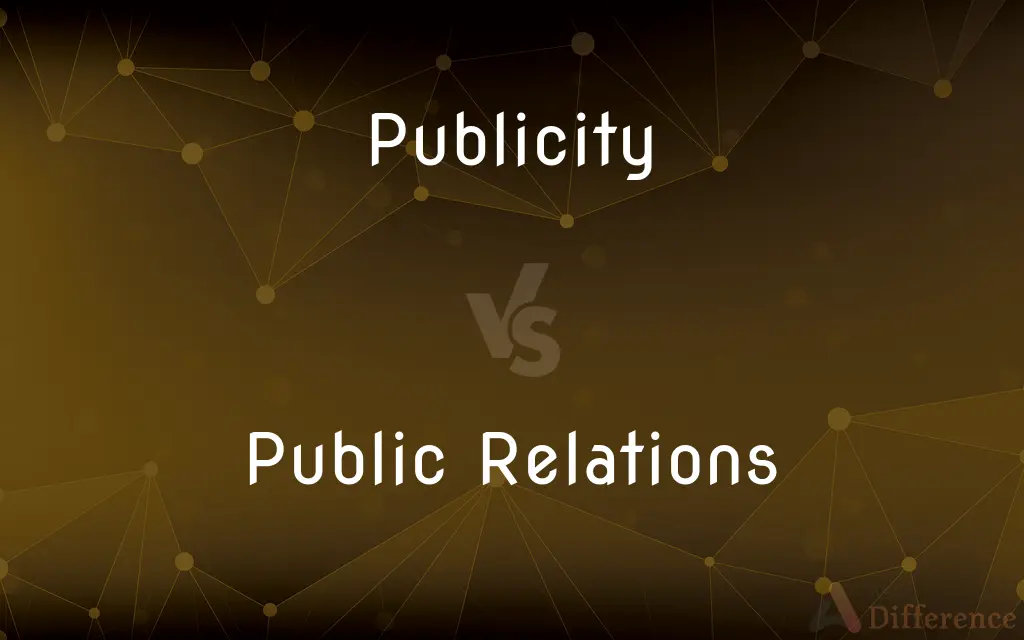Publicity vs. Public Relations — What's the Difference?
By Tayyaba Rehman — Published on October 5, 2023
Publicity involves disseminating information to gain public attention, whereas Public Relations (PR) is a strategic communication process that builds mutually beneficial relationships between organizations and their publics.

Difference Between Publicity and Public Relations
Table of Contents
ADVERTISEMENT
Key Differences
Publicity typically pertains to spreading information to gain public attention or awareness for a product, person, or service. It is primarily one-way communication, where an organization sends out information without fostering interactions or engagement. Publicity generally does not have a direct strategy or intention behind maintaining relationships and is more concerned with spreading information widely.
In contrast, Public Relations is a broader, strategic communication process that aims to build and maintain a positive image and mutually beneficial relationships between an organization and its publics. Public Relations involves a more deliberate, strategic communication and actions performed by a company to enhance its image and establish a strong relationship with its audience, managing both the message and the messenger.
In the realm of Publicity, the communication is often uncontrolled since once the information is out, the organization has no control over how it is used or spread. This implies that Publicity can be positive, neutral, or negative depending on how media outlets and individuals choose to interpret or use the information.
Conversely, Public Relations aims to carefully manage and control the message by strategically planning how, when, and where the information will be disseminated. Public Relations places importance on ensuring that the information enhances the company’s image and strengthens its relationships with its target audience, navigating through potential positives and negatives adeptly.
The objective of Publicity is largely to gain attention and it is often regarded as more short-term in nature. It tends to emphasize getting a message out to the public quickly and does not generally engage in building and maintaining long-term relationships or in strategic reputation management.
ADVERTISEMENT
Public Relations, however, keeps a firm eye on the long-term perspective. It is not just about delivering messages but ensuring that these messages are consistent, reliable, and build upon the organization’s reputation and relationships over time. Public Relations incorporates sustained efforts to craft a positive image and healthy relationships with various stakeholders.
Comparison Chart
Goal
Gaining attention and awareness
Building and maintaining relationships and image
Communication Flow
Often one-way
Can be two-way
Control
Limited control over message after release
Strategic control over message and dissemination
Duration & Perspective
Generally short-term and immediate
Focused on long-term relationships and reputation
Nature
Can be positive or negative
Primarily aims to be positive
Compare with Definitions
Publicity
Spreading information to enhance public awareness.
The product launch gained immense Publicity on social media.
Public Relations
Building and safeguarding the reputation of an organization.
Public Relations played a key role in establishing the brand’s credibility.
Publicity
Non-strategic communication aiming for public attention.
The viral video provided unexpected Publicity for the brand.
Public Relations
Managing and controlling an organization’s message and image.
Public Relations teams control how corporate messages are conveyed.
Publicity
Gaining attention without necessarily managing relationships.
The celebrity’s mishap attracted unintended Publicity.
Public Relations
Strategic communication to enhance organizational image.
Public Relations efforts mitigated the crisis impact on the company.
Publicity
Generating attention toward a product, person, or service.
Her charitable actions drew positive Publicity in the press.
Public Relations
Nurturing positive associations between an entity and its audiences.
Public Relations campaigns fostered positive community relations.
Publicity
Public interest, notice, or notoriety generated or gained by disseminating information through various media
The book has received widespread publicity.
Public Relations
Maintaining mutually beneficial relationships with publics.
Effective Public Relations strategies built a solid customer base.
Publicity
The act, process, or occupation of disseminating information to gain public interest
The company's ongoing publicity of its new product.
Has a job in publicity.
Public Relations
Public relations in attributive use
Publicity
Information about someone or something that is disseminated through various media to attract public notice
The publicity that went out about the film was not very exciting.
Publicity
(Archaic) The condition of being public.
Publicity
Advertising or other activity designed to rouse public interest in something.
Publicity
Public interest attracted in this way.
Publicity
The condition of being the object of public attention.
Publicity
The quality of being public, not private.
Publicity
The quality or state of being public, or open to the knowledge of a community; notoriety; publicness.
Publicity
A message issued in behalf of some product or cause or idea or person or institution
Publicity
Gaining attention through disseminated information.
The movie gained huge Publicity after the surprise trailer drop.
Common Curiosities
How does Public Relations manage an organization’s reputation?
Public Relations employs strategic communication and actions to enhance and protect the organization’s image and relationships with its publics.
What is Publicity?
Publicity involves disseminating information to gain public attention and awareness, often without direct strategic intention.
Can Publicity be negative?
Yes, Publicity can be positive, neutral, or negative, as control over the message is often limited once it's released.
How does Public Relations approach communication?
Public Relations strategically plans communication to manage how, when, and where messages are disseminated to nurture a positive organizational image.
Is Publicity always planned by the organization?
Not always, Publicity can be planned or unplanned, with messages sometimes spreading organically or unexpectedly.
Is Publicity typically a short-term effort?
Publicity often has a more immediate and short-term focus, primarily aimed at quick message dissemination without the intent of relationship building.
Does Public Relations focus on long-term or short-term goals?
Public Relations emphasizes long-term goals, focusing on sustaining and enhancing organizational relationships and reputation over time.
How does Public Relations differ from Publicity?
While Publicity seeks attention, Public Relations strategically builds and maintains positive relationships and image between organizations and their publics.
Can Publicity be controlled after information release?
Publicity often allows limited control over the message and its spread once the information has been released to the public.
Share Your Discovery

Previous Comparison
Craftsmanship vs. Artistry
Next Comparison
Microprocessor vs. MicrocontrollerAuthor Spotlight
Written by
Tayyaba RehmanTayyaba Rehman is a distinguished writer, currently serving as a primary contributor to askdifference.com. As a researcher in semantics and etymology, Tayyaba's passion for the complexity of languages and their distinctions has found a perfect home on the platform. Tayyaba delves into the intricacies of language, distinguishing between commonly confused words and phrases, thereby providing clarity for readers worldwide.
















































